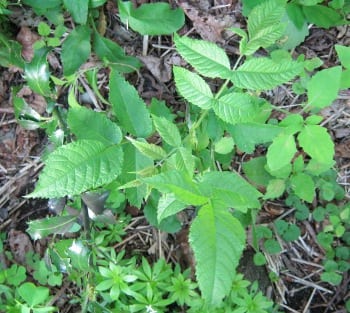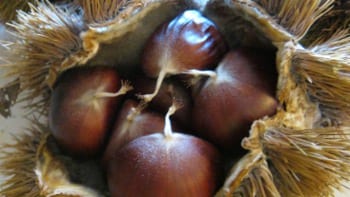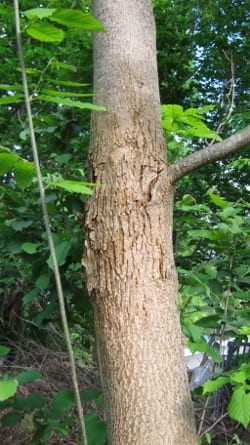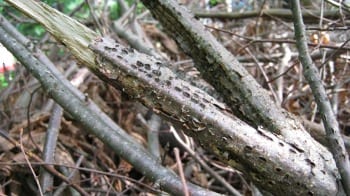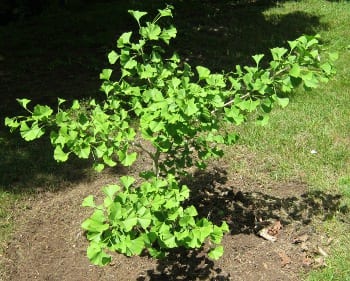by Tricia Diggins
Nut trees, more than any other aspect of landscaping, make me think of the old proverb “The best time to plant a tree is 20 years ago, the second best time is now.” So, plan to plant a nut tree this fall or next spring. If you for some reason cannot plant one, find one to protect because mature nut trees seem to be getting rarer. Yes, there is a lot to learn about nut trees but you can learn it after the tree is in the ground and growing. This article will raise some of the issues surrounding growing nut trees and while my experience is in Massachusetts much of the information will be applicable to anywhere the species I mention will grow.
My first piece of advice is to join the Northern Nut Growers Association (NNGA). I started growing nuts as a hobbyist because of an interest in edible landscaping. I get excited about growing nuts when I read about people in the NNGA who have dedicated their lives to learning about and improving how we grow this valuable food source.
The importance of nut trees in an ecosystem for the food and habitat they provide for organisms from insects to people is reason enough to plant nuts. Most of the nuts I’ll mention are native to central and Eastern North America so planting these trees is a win-win situation – they are both edible and native plants. Probably the biggest reason not to grow nut trees is that they are big trees. There are a few species, like the hazelnuts (Corylus sp.) or chinquapins (Castanea pumila), that could be grown on a small city lot, but for the most part one should plan for the future and hope that the tree you plant will benefit you and/or the surrounding wildlife for a long time and not outgrow its space. Another consideration is that, like smaller fruit trees, you often need a second tree for pollination, so you may need room for at least two trees of the same species if there are not wild trees close by.
The Species
Oaks – Quercus sp.
Oaks are the most important nut trees. However, while acorns are edible by humans and were and probably will again be an important food crop, the focus of this article is on more palatable nuts.
Walnuts – Juglans sp.
Black Walnut – Juglans nigra
This is a native tree known for having very valuable timber and very tough nuts to crack. It is the best choice for a reliable crop of nuts. There are many improved cultivars and work continues to find more. You will have to plan if you want to plant this near other garden plants since some plants are sensitive to juglone which is an alellopathic chemical produced by the black walnut to discourage competition from other plants and protect against insects. Black walnuts do seed around and can be difficult to remove, so pull them young if they are in an unwanted spot.
Butternut – Juglans cinerea
The nuts of this tree were used by Native Americans and European settlers for food and dyes. The species is on the verge of extinction in the wild because of a canker disease, but work is being done to find resistant butternuts.1
English or Carpathian Walnut – Juglans regia
This is the walnut we are most familiar with from baked goods and in shell nut mixes. There are varieties of this tree that are more cold hardy than others so it is potentially hardy to zone 5 but it is unlikely to produce well due to frosts and other factors.
Hickories – Carya sp.
Hickories too often blend into the background of southern New England forests until fall when their deep yellow fall foliage gets them noticed. Or you may be lucky enough to have Shagbark hickories in your neighborhood. Their distinctive shaggy bark makes identification easy. I hope most people have had the experience of finding hickory nuts in the wild and sampling them because they are delicious and not very available to purchase. The two species that are desirable and have some selected cultivars are C. ovata, the shagbark hickory, and C. laciniosa, the shellbark hickory. A couple of the hickory species do not have good tasting nuts.
Hickories are closely related to the pecan (Carya illinoensis). Like the English walnut, pecans can survive to zone 5, but they are unlikely to produce nuts.
Chestnuts – Castanea sp.
The tragic story of how the eastern US forests lost the magnificent American chestnut (Castanea dentata) in the early 20th century to an Asian fungal blight is known to most people interested in trees. The trees are reduced to suckering stumps because the roots survive the fungal attack and continue to send up shoots which then eventually succumb to the blight. Since I think everyone should know that story, I’m always surprised when people talk about the big chestnut they grew up with and eventually I have learned they are usually talking about a horse chestnut or buckeye (Aesculus sp.). Horse chestnuts are not edible because they contain alkaloids that make them toxic, though ingestion is rarely fatal.2
Despite the heroic efforts of the American Chestnut Foundation and other researchers trying to breed resistance to the fungus into American chestnuts with crosses from the resistant Chinese chestnut (C. mollis), it is still not advisable to plant an American chestnut in expectation of a nut harvest. Hybrids of America chestnuts with Chinese chestnuts, pure Chinese chestnuts, European chestnuts (C. sativa), and Japanese chestnuts (C. crenata) all offer the possibility of harvest before potentially being compromised by blight.
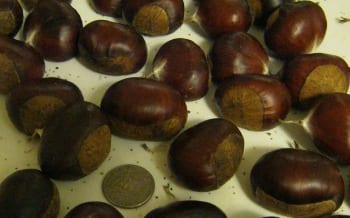
Although most American chestnuts have succumbed to blight and horse chestnuts contain toxic alkaloids, some hybrid chestnuts offer promise of producing a crop.
I planted two Douglass hybrid chestnuts in my yard. They are a cross of American and Chinese chestnuts, with possibly some of the native chinquapin in the parentage.3 One of the trees was reduced to a suckering shrub after a couple of years because of blight and has never produced a decent nut. The second tree has been remarkable, producing beautiful nuts even though it lives with a major canker from the blight on its trunk. Between the blight and the damage from last year’s freak October snowstorm, the tree’s days are likely numbered. (At the least, the main trunk will die.) There are two other problems one should be aware of with chestnuts. The burrs (the outer casing on the nuts) are painfully prickly and need to be handled with gloves; however, that casing keeps the squirrels away long enough to actually have a nut harvest if you collect the nuts each day when the burrs are dropping in the fall. And like acorns, chestnuts are host to a weevil whose larvae are in many of the nuts. There are various control methods, but they are beyond the scope of this article. I do want people to realize that many other organisms want to enjoy the protein, fat and/or carbohydrate filled nuts.
I mentioned that my Douglass hybrid chestnuts may have some chinquapin in their ancestry. The native chinquapin is a possible nut tree for a small space. They are a wonderful native tree or shrub worth trying, but they are not blight resistant.
Hazelnuts or Filberts – Corylus sp.
The hazelnuts we can buy in the store are the European hazelnut, Corylus avellana. There are a couple of native hazelnuts in the east, C. americana and C. cornuta which, while good for foraging, have not been improved and do not compare in size or productivity to the European hazels and their hybrids. European hybrids grow very well in Massachusetts, but, in a sad twist of the chestnut story, a native fungus to which the native filberts are resistant, Eastern Filbert Blight (EFB), eventually kills European hybrids. I have a stand of hazelnut hybrids, but after 13 year they are in steep decline with EFB. Some hybrids are listed in nursery catalogs as having some resistance, but eventually they all succumb.4 The Chinese Hazelnut (C. chinesis) currently shows promise for nut production and blight resistance.5 In the case of hazelnuts, perhaps the best option would be to plant the native species in support of local insect and wildlife populations.
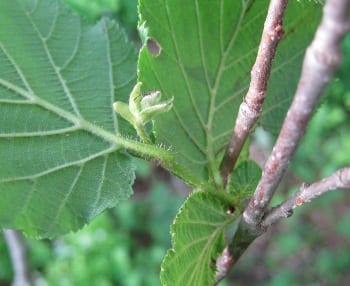
Tiny nuts have formed on my hazelnut hybrids this spring though the trees are in decline with Eastern Filbert Blight.
Other nuts with some promise include gingko and pine. Gingko nuts have an offensive odor due to an outer fleshy cover on the nut, but they are used in Asian cultures and maybe could be in the US. Gingkos are tough trees, though female trees are hard to find in the nursery trade because the males are more desirable as street trees. Also, pine nuts are produced by several species of pine, some are very hardy, and are worth investigating.
Acquiring a Nut Tree
I think the best way to plant a nut tree would be to find a local tree and plant a nut from that tree. Fostering the offspring of a local resident would create a wonderful connection to a place. Some trees species are easier to grow from a seed than others, but those details are beyond the scope of this article. If you choose to grow a tree from a nut, always protect your nut seeds from squirrels, even after the seed has sprouted. An impenetrable cage of hardware cloth will probably be necessary.
The easiest way to get a nut tree is to buy one from a nursery. In New England that nursery will likely be a mail order nursery. Nut trees are sold small because most have a tap root and that makes them difficult to sell as container plants or in larger sizes. I once bought some shagbark hickory bare root seedlings whose top shoots were about 5 inches in length while the root was about 18 inches. I have bought many nut trees from mail order nurseries, and the quality at all the nurseries has ranged from great to poor. Most of the named cultivars of nut trees are grafted and the graft union is not always strong. I would not hesitate to order from the same nurseries again because I am really glad they are propagating nut trees, but I am guessing that demand is currently outstripping supply and sometimes they sell some of their weaker plants because of low stock. (So not only should you plant a nut tree, but you should think about starting a nut nursery.)
Our Attachment to Trees
As I write this article, I am not just thinking about all the great reasons to grow a nut tree. I am also thinking of a remarkable shagbark hickory that was at the intersection near my house. The tree was growing between the edge of a gas station parking lot and a compacted dirt traffic turnaround. It had poison ivy climbing up it and signs nailed all over it, yet the canopy was full and showed no signs of dieback. I knew it was doomed because the intersection was going to be widened, so I went over the fall before construction started and gathered nuts from the ground. It happened to be a mast year (a bumper crop), and there were plenty of nuts.
I planted the nuts in my yard and in pots at home and at work. Squirrels got the ones at work. Two seeds sprouted in pots at home, but the plants failed to thrive and died. I was sad my efforts had failed. Then, later in the year after the mother tree was taken down, I was preparing to have a rotted shed in my yard demolished. In an old ash stump next to the shed was a hickory seedling. I moved the seedling to the back edge of my yard, and even though I did not get the entire tap root the tree is still alive three years later.
I tell this story for two reasons. I think people connect emotionally to nut trees because those of us old enough often have a memory of a certain nut tree or of gathering nuts with family. Remembering an old nut tree will likely be another aspect of nature our children will not get to experience. But I cannot end on such a nostalgic note. In reality, that particular shagbark hickory must have had an exceptional genetic makeup to live in such a difficult situation, and these are the trees we cannot afford to lose. We will need such resilient trees to improve the species of each of the nut trees. The hope is that through luck, or most likely with human intervention, the trees can recover from the diseases and other stresses attacking them and continue to support the organisms that depend on them. So think more about nut trees, and then go plant one.
End Notes
1. Keith Woeste and Paula Pijut, “The Peril and Potential of Butternut,” Arnoldia 66.4 (2009): 10.
2. Nova Scotia Museum, “Horse-Chestnut”, The Poison Plant Patch, http://museum.gov.ns.ca/poison/?section=species&id=64.
3. Pat Chamberlaine, “The Douglass Hybrids: a Case of Mistaken Identity,” 94th Annual Report of the Northern Nut Growers Association 94 (2003), pg 57-64.
4. Charles Rhora, “Observation of the Development of the Corylus (hazelnut or filbert) and Eastern Filbert Blight Resistance Over Time,” The Nutshell 65 (4), pg 6.
5. Rhora, pg 6.
Other References
A Guide to Nut Tree Culture in North America. Ed. Dennis Fulbright. Northern Nut Growers Association, 2003.
Smith, J. Russell. Tree Crops: A Permanent Agriculture. Island Press. 1929. Greenwich, CT: Devin-Adair Company, 1950.
Anagnostakis, Sandra. “American Chestnuts in the 21st Century.” Arnoldia 66.4 (2009):22-31.
About the Author
Tricia Diggins is the Senior Gardens Horticulturalist at Wellesley College where she has taken care of the Arboretum/Botanic Garden for nearly 20 years. She began her horticulture career as an intern at New England Wildflower Society’s Garden in the Woods in 1990 several years after earning a B.S. in Environmental Sciences at UMass Amherst. When Tricia isn’t caring for the plants at Wellesley College, she is developing and maintaining a third of an acre edible landscape. Tricia may be reached at pdiggins@wellesley.edu.

